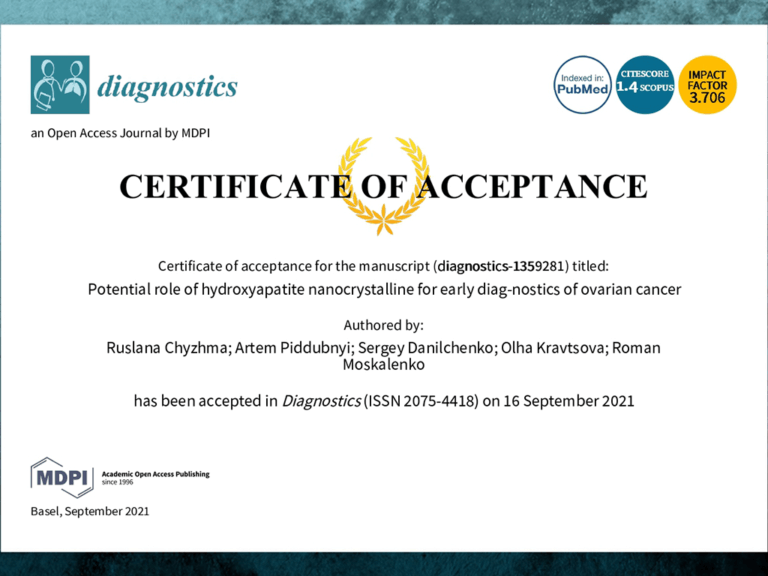Scientists from the Ukrainian-Swedish Research Center SUMEYA published the paper “Potential role of hydroxyapatite nanocrystalline for early diagnostics of ovarian cancer” in the journal “Diagnostics“. This journal has an impact factor of 3.7 and is included in the Q2 Scopus databases (Chyzhma, R.; Piddubnyi, A.; Danilchenko, S.; Kravtsova, O.; Moskalenko, R. Potential Role of Hydroxyapatite Nanocrystalline for Early Diagnostics of Ovarian Cancer. Diagnostics 2021, 11 1741 https://doi.org /10.3390/diagnostics11101741).
This paper is assigned to a detailed study of the morphology and the composition of specific ovarian cancer calcifications, which are composed of hydroxyapatite. Since nanosized calcifications appear in tumor tissue at early stages, it could be a basis for the development of new technology for screening and early diagnostics of ovarian cancer. It provides a comparative analysis of calcifications sizes and the resolution of minimally invasive diagnostic methods. There is the comparison of the results of ultrasound and histology and it was found that calcifications of a size less than 200 μm are not detected by ultrasound. At the same time, CT scans detect pathological deposits of 1000 μm and bigger. IVUS visualizes calcification with a size of more than 100 μm. OCT can recognize biomineral inclusions with a size of 10–20 μm and more. Technological advances make it possible to diagnose ever-smaller objects. This obviously depends on the composition of pathological biominerals, as well as on the maturity of the biomineral and its structure.
There is a strong correlation between tumor size and calcification. It was found that tumors without calcification had significantly bigger sizes. This indicates a possible positive role (tumor suppression) of calcifications in ovarian tumors.
Thus, the detection of nanocrystalline particles will contribute to the detection of tumors at the initial stages of cancerogenesis. This confirms the hypothesis about the possible application of high-resolution techniques for early cancer diagnostics.
Therefore, the study of the structure and physical, chemical and phase composition of ovarian cancer calcifications, as well as features of their visualization, is important since provides the possible practical application of this pathological phenomenon for early diagnostics of ovarian cancer and other neoplasms with biomineralization.
Link to the paper: https://www.mdpi.com/2075-4418/11/10/1741/html
